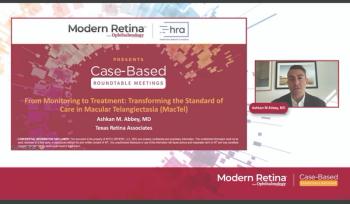
ARVO 2023: Luxa Biotechnology shares progress of Phase 1/2a clinical trial for AMD treatment
At ARVO in New Orleans, Luxa Biotechnology shared an update on the progress of a Phase 1/2a clinical trial evaluating transplantation of RPESC-RPE-4W to treat dry age-related macular degeneration (AMD).
At the annual ARVO meeting held in New Orleans, Luxa Biotechnology shared the progress of a Phase 1/2a clinical trial evaluating transplantation of RPESC-RPE-4W as a treatment for dry age-related macular degeneration (AMD). The panel discussion was moderated by Supriya Menezes, associate vice president of ophthalmology at Emmes, a global, full-service clinical research organization that hosted the session.
According to LuxaBio, RPESC-RPE-4W is derived from an adult retinal pigmented epithelium stem cell (RPESC) that produces retinal pigmented epithelium (RPE) cell progeny. The cell product being used in the clinical trial is a progenitor stage RPESC-RPE obtained after 4 weeks of differentiation (RPESC-RPE-4W).
The company noted the trial is being conducted at the University of Michigan Kellogg Eye Center.
“Our unique technology utilizing progenitor-stage RPE cells to replace those lost in dry AMD offers the potential to improve vision,” said Jeffrey Stern, MD, PhD, co-CEO of LuxaBio and co-founder of NSCI. “This trial represents a close collaboration of LuxaBio, the Kellogg Eye Center, the Cedars-Sinai Biomanufacturing Center, the National Eye Institute, and Emmes, our contract research organization and sponsor of the panel session at ARVO.”
Laboratory studies of RPESC-derived RPE cells demonstrated they could perform the critical repertoire of cell functions carried out by normal RPE cells, including trophic factor release and phagocytosis. Sub-retinal implantation in an animal model of retinal degeneration showed that RPESC-RPE-4W cells engraft into the RPE layer.
Transplanted RPESC-RPE-4W provided durable preservation of RPE cell functions and supported overlying photoreceptor cells, resulting in vision rescue that was maintained for the life of the animal. RPESC-RPE-4W has significant safety attributes in animal models, including lack of tumor formation.
Adult RPESC are obtained from eyes donated to eye banks. A single donor produces sufficient RPESC-RPE-4W cells for several hundred doses. The RPESC-RPE-4W cell product is manufactured at the Cedars Sinai Biomanufacturing Center in Los Angeles and the formulated doses are shipped to the clinical site for implantation.
The trial is co-sponsored by the National Eye Institute of the National Institutes of Health under a Regenerative Medicine Innovation Project cooperative agreement.
Newsletter
Keep your retina practice on the forefront—subscribe for expert analysis and emerging trends in retinal disease management.












































